007 Movies in Order of Release
Time for a look at 007 movies in order of release. The James Bond franchise has had a significant influence on modern cinema and popular culture since its inception. With a legacy spanning over six decades, 007 movies have not only introduced us to the coolest spy, but it has also reshaped our understanding of the action genre.
The journey began in 1953 when British author Ian Fleming introduced the world to James Bond, an enigmatic and suave secret agent with a license to kill. Following the success of his novels, the first James Bond movie, Dr. No, graced the big screens in 1962, featuring Sean Connery in the now iconic role of Bond, James Bond.
Since then, the franchise has expanded into an impressive collection of 25 official and 2 unofficial 007 movies. In this article, we’ll take an overview of all 007 movies in order of their release, and point out one of each movie’s iconic scenes.
So, whether you are a lifelong Bond fan or a newcomer to the franchise, this article will serve as a guide to navigate through the world of 007.
007 Movies of the 1960s
The 1960s marked the beginning of the Bond franchise, where the world first got a glimpse of the suave and sophisticated MI6 agent.
The 1960s laid the groundwork for the Bond franchise, establishing the charismatic hero, outlandish villains, incredible gadgets, and the exotic locations that have become quintessential features of the James Bond narrative.

Bond 1: Dr. No (1962)
The inaugural film that launched the franchise, Dr. No, introduced audiences to Sean Connery’s portrayal of James Bond. The plot revolves around Bond’s mission to Jamaica to investigate the disappearance of a fellow British agent, leading to a confrontation with Dr. Julius No, a nefarious scientist with a plot to disrupt an American space launch.

Bond 2: From Russia with Love (1963)
From Russia with Love holds a significant place in the 007 movies in order as the second film featuring Connery as James Bond. Closely based on the novel, in this thrilling installment, Bond finds himself pitted against the formidable global criminal organization known as SPECTRE, who are out for revenge after Bond killed their man Dr. Julius No.

Bond 3: Goldfinger (1964)
In Goldfinger, Bond takes on Auric Goldfinger, a villain with a love for gold and a plan to infiltrate Fort Knox. It introduced several franchise staples, such as advanced gadgets, including the famous Aston Martin DB5, and it’s often hailed as one of the best in the series.
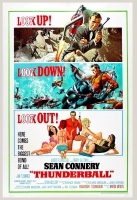
Bond 4: Thunderball (1965)
Fourth in the order of 007 movies is Thunderball, which sees James Bond venturing to the Bahamas to recover two stolen nuclear warheads. This film is famous for its underwater action sequences, a precedent for the adventurous and exotic locales that future Bond films would explore.

Bond 5: You Only Live Twice (1967)
In You Only Live Twice, Bond travels to Japan to investigate the hijacking of American and Soviet spacecraft. The film is known for its exotic locations, innovative gadgets, and the introduction of Bond’s arch-nemesis Ernst Stavro Blofeld, played by Donald Pleasence.
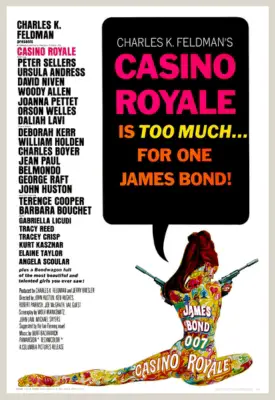
Casino Royale (1967) Unofficial
This unofficial spoof of the Bond series starred David Niven as an older, retired James Bond. While not canon, Casino Royale (1967) is noteworthy for its comedic take on the spy genre and its all-star cast, which included Peter Sellers and Ursula Andress who played Vesper Lynd.

Bond 6: On Her Majesty’s Secret Service (1969)
The final 007 movie of the 60s brought with it a change in the lead role, with George Lazenby stepping into Bond’s shoes for his only appearance in the series. On Her Majesty’s Secret Service is often noted for its more emotive storyline, focusing on Bond’s love story with Tracy di Vicenzo, and the tragedy that ensues. This movie also sees the return of Blofeld, Bond’s nemesis, this time played by Telly Savalas.
007 Movies of the 1970s
Within the chronological timeline of the 007 movies in order, the 1970s marked a pivotal era as the Bond franchise maintained its worldwide supremacy.
The 1970s marked a departure from the more grounded Connery films, embracing a campier, more humorous tone that would define the Roger Moore era. The decade solidified the franchise’s popularity and paved the way for the larger-than-life 007 adventures that were to come.

Bond 7: Diamonds Are Forever (1971)
Sean Connery made a stunning comeback to the series for one last time in Diamonds Are Forever. The movie showcases Bond’s investigation into a diamond smuggling operation, leading him to Las Vegas, where he encounters his old enemy, Blofeld, played by Charles Gray, who’s intent on constructing a laser satellite with diamonds.

Bond 8: Live and Let Die (1973)
Roger Moore made his debut as Bond in Live and Let Die, marking the beginning of a new era in the franchise. This movie is set in the backdrop of voodoo and black magic, as Bond is up against a powerful drug lord, Mr. Big. Moore brought a lighter touch to the character, with the series increasingly venturing into humor and self-parody during his reign.

Bond 9: The Man with the Golden Gun (1974)
Continuing his journey as Bond, Roger Moore’s second movie, The Man with the Golden Gun, sees Bond pitted against the assassin Francisco Scaramanga, played by Dracula legend Christopher Lee. The film is notable for its unique villain and his assistant Nick Nack, memorable locations, and the funhouse climax on Scaramanga’s “James Bond Island“.

Bond 10: The Spy Who Loved Me (1977)
The Spy Who Loved Me is often considered one of Roger Moore’s best Bond films. Here, Bond and Soviet agent Anya Amasova form an unlikely alliance to locate missing submarines before they are used to cause World War III. The film is famous for the introduction of Jaws, one of the most iconic Bond henchmen, and the unforgettable Lotus Esprit submarine car.

Bond 11: Moonraker (1979)
Moonraker took Bond to new heights, literally, as he ventured into space. The film follows Bond’s mission to stop a madman’s scheme to destroy the world and rebuild it in space. Known for its outlandish plot and impressive special effects, Moonraker embodies the humorous and fantastical spirit of the Roger Moore era.
007 Movies of the 1980s
The 1980s were an important decade for the Bond franchise, seeing a shift from the light-hearted tone of the 70s towards a grittier and more serious Bond, especially with Dalton’s portrayal, setting the stage for the more dramatic and complex Bond films of the future.
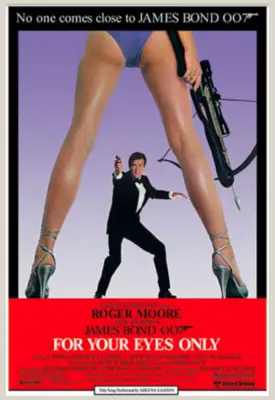
Bond 12: For Your Eyes Only (1981)
Roger Moore’s fifth turn as Bond, For Your Eyes Only, sees the spy heading to Greece and Italy to recover a British encryption device before it falls into enemy hands. The film is appreciated for its down-to-earth approach and a more serious tone compared to its immediate predecessors.

Bond 13: Octopussy (1983)
Octopussy sees Bond uncovering a plot to detonate a nuclear bomb at a US military base in Germany, potentially triggering a global conflict. This movie is particularly remembered for its mix of action, humour, and exotic locations, including India.

Never Say Never Again (1983) Unofficial
This unofficial Bond movie saw the return of Sean Connery to the role of 007 after a 12-year absence. A remake of Thunderball, the film isn’t part of the main Eon Productions series, but is notable for Connery’s performance and its unique place within Bond history. It was relased at roughly the same time as Octopussy and both competed at the Box Office.
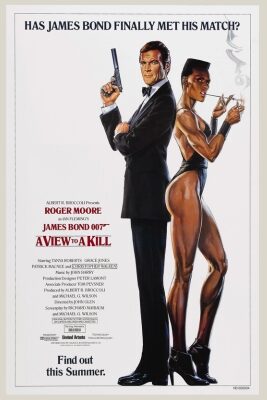
Bond 14: A View to a Kill (1985)
Roger Moore’s final Bond movie, A View to a Kill, pits Bond against the villainous Max Zorin, who plans to destroy Silicon Valley to monopolize the microchip market. Moore’s swansong is marked by his charismatic performance and the memorable performance from Zorin’s unique henchwoman May Day.

Bond 15:. The Living Daylights (1987)
The introduction of Timothy Dalton as Bond in The Living Daylights marked a significant tonal shift in the series. The movie, revolving around a plot involving a defecting Soviet general, has been praised for its grounded nature, echoing the seriousness of the early Connery films.

Bond 16: Licence to Kill (1989)
Dalton’s second and final movie as Bond, Licence to Kill, is one of the grittiest films in the series. When Bond’s friend Felix Leiter is left for dead by ruthless drug lord Franz Sanchez, Bond sets out on a personal vendetta, displaying a more ruthless and revenge-driven Bond than seen before.
007 Movies of the 1990s
The 1990s marked the arrival of the sixth actor to portray James Bond: Pierce Brosnan, whose charisma and the movies’ mix of classic Bond elements with modern sensibilities helped the series remain a potent force in the evolving landscape of action cinema.

Bond 17: GoldenEye (1995)
After a six-year hiatus, James Bond returned to the big screen in GoldenEye, with Pierce Brosnan making his debut as the suave secret agent. The movie follows Bond’s mission to prevent a rogue MI6 agent from using a satellite weapon against London to cause a global financial meltdown. GoldenEye is credited with revitalizing the Bond franchise, updating it for a post-Cold War world while introducing the first female M, played by Judi Dench.

Bond 18: Tomorrow Never Dies (1997)
Tomorrow Never Dies pits Bond against a media mogul who attempts to start a war between the UK and China for TV ratings. Known for its thrilling action sequences and its commentary on media influence, the film cements Brosnan’s energetic and smooth portrayal of the character.

Bond 19: The World Is Not Enough (1999)
In The World Is Not Enough, Bond takes on a mission to protect oil heiress Elektra King from her former kidnapper, an international terrorist who can’t feel pain. The movie delves deeper into M’s character and challenges Bond’s loyalty to his superiors, illustrating the increasingly complex narratives of the Bond franchise. The movie also marked the departure of longtime Q actor Desmond Lewellyn.
007 Movies of the 21st Century
The 21st century brought significant changes to the Bond franchise, with an evolving style reflective of the times and the introduction of the sixth official James Bond, Daniel Craig. These movies strived to balance the iconic elements of the Bond franchise with the evolving expectations of the modern audience, showcasing a more grounded and somewhat emotive Bond.

Bond 20: Die Another Day (2002)
Marking the 20th film and the 40th anniversary of the franchise, Die Another Day is Pierce Brosnan’s final outing as James Bond. The plot sees Bond investigating a North Korean military officer’s illegal diamond trade to finance weapon development. The movie is known for its high-tech gadgets, including an invisible car, and an Oscar-nominated theme song by Madonna.

Bond 21: Casino Royale (2006)
Casino Royale is the first Daniel Craig outing as the new James Bond in a plot that takes the character back to his early days as a newly promoted Double-O agent. This movie sees Bond in a high-stakes poker game against the terrorist financer, Le Chiffre. Casino Royale is often praised for its grounded and gritty tone, refreshing the franchise and bringing a sense of vulnerability and humanity to the character.

Bond 22: Quantum of Solace (2008)
Serving as a direct sequel to Casino Royale, Quantum of Solace finds Bond out for revenge while uncovering a coup d’etat plot in Bolivia. Despite mixed reviews, the film is recognized for its action sequences and exploration of Bond’s character development.

Bond 23: Skyfall (2012)
Celebrating the 50th anniversary of the franchise, Skyfall sees Bond’s loyalty to M tested as her past comes back to haunt her. The film was acclaimed for its storytelling, cinematography, and performances, especially Javier Bardem as one of the best Bond villains, Raoul Silva. Skyfall was a massive box-office success and is often ranked among the best movies in the franchise.
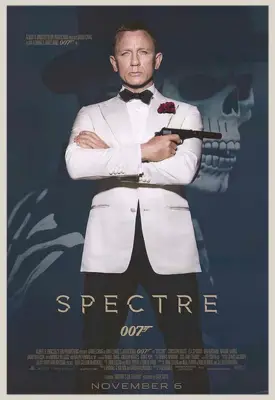
Bond 24: Spectre (2015)
Spectre brings back the eponymous criminal organization not seen since the Connery era. The movie features a link between all of Craig’s Bond films, tying together loose ends and delving into Bond’s past. While receiving mixed reviews, Spectre is noteworthy for its continuous opening tracking shot, action sequences, and Christoph Waltz‘s performance as Blofeld.

Bond 25: No Time to Die (2021)
Concluding Daniel Craig’s tenure as Bond, No Time to Die sees Bond coming out of retirement to face a new villain with dangerous technology. The movie pays homage to Craig’s era while wrapping up his story arc. It’s recognized for its emotional depth, action scenes, and performances from its cast, especially Craig’s swansong as the iconic spy.
007 Movies in Order of Release
From its inception in the 1960s to its modern installments, the Bond franchise’s longevity is testament to its ability to evolve and captivate audiences worldwide.
Following the 007 movies in order, one can observe the shifting cultural, political, and cinematic landscapes of their respective periods. The franchise’s deftness at reinvention – from Sean Connery’s quintessential Bond to Daniel Craig’s rugged and emotive iteration – helps to ensure its relevance and appeal.





